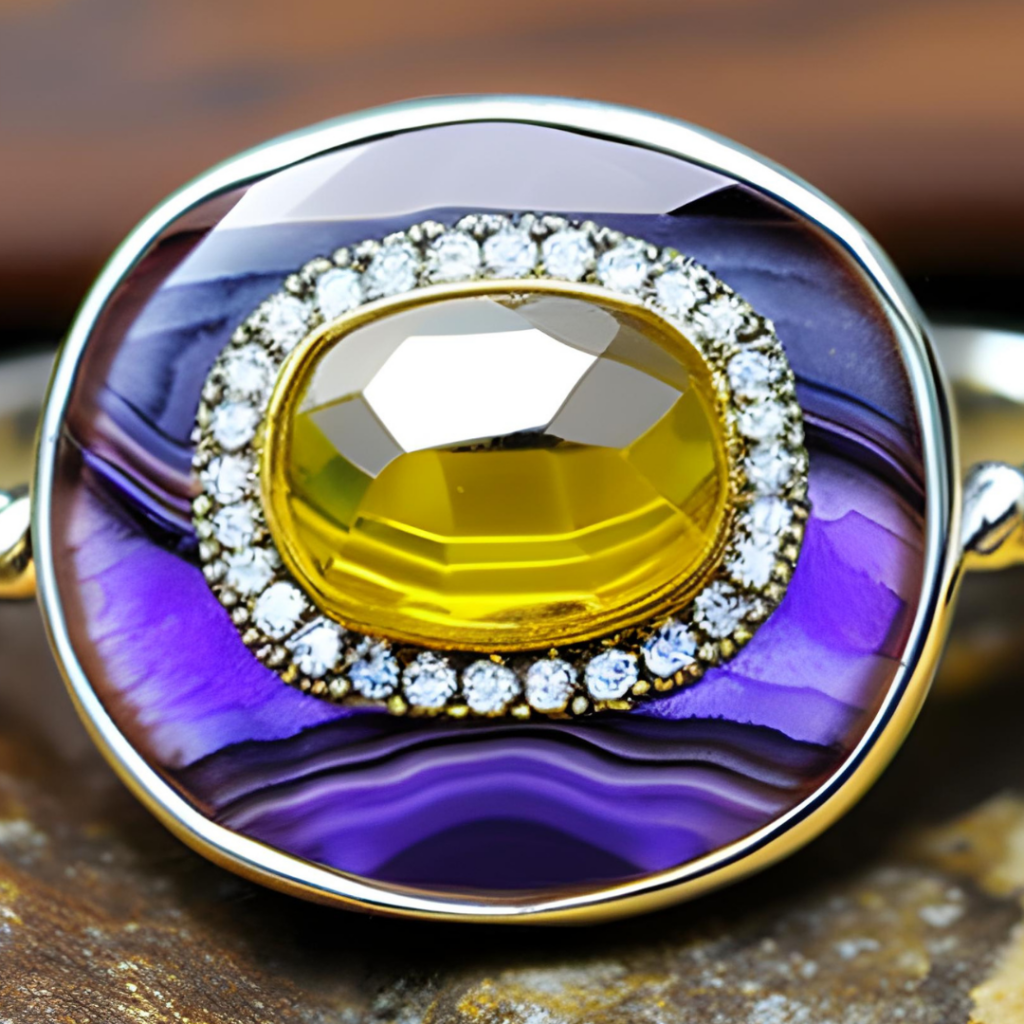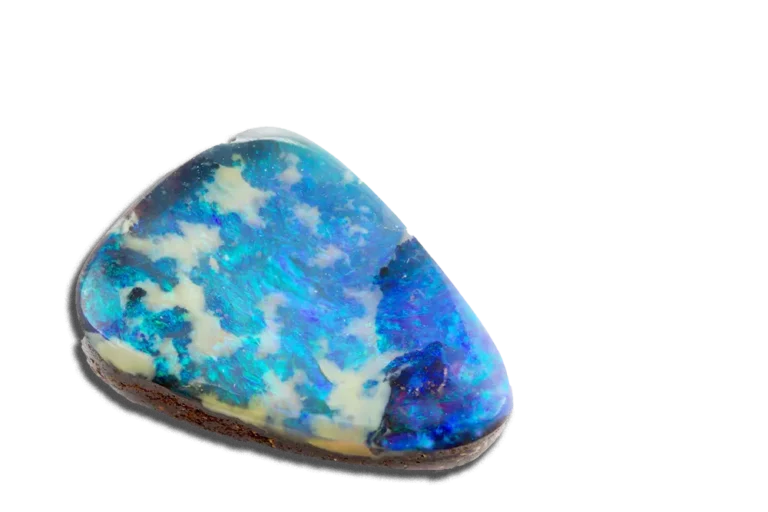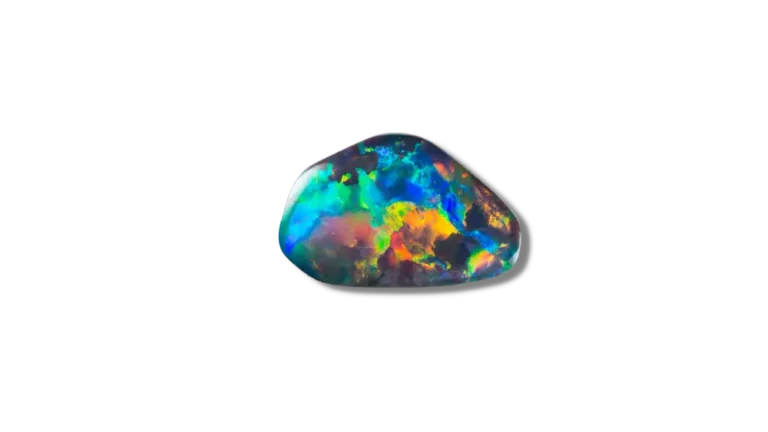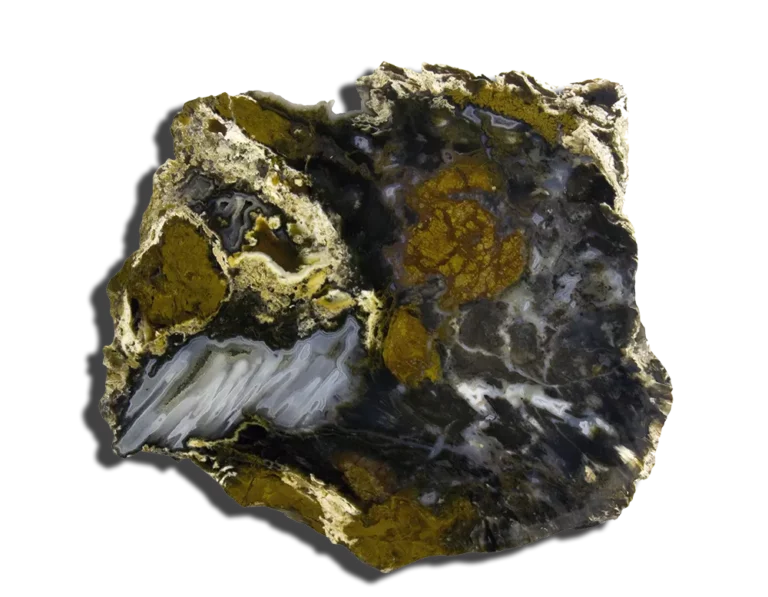Iris Agate: Properties, Benefits & Meanings

Iris Agate Overview
Iris Agate, also known as Rainbow Agate, is a unique gemstone known for its beautiful and iridescent colors. It is a type of chalcedony formed when silica-rich fluids fill the cavities in volcanic rocks and solidify over time. The gemstone’s distinctive colors are caused by light interference within the microscopic layers of the stone. It can be found in shades of blue, green, pink, and purple, with each stone’s unique pattern and coloration.
The stone is believed to have healing properties, with some people using it to enhance mental clarity and improve emotional balance. Iris Agate is a fascinating and exquisite gemstone that continues to captivate people with its stunning hues and intricate patterns.
Keep reading this article as we delve into this gem’s secrets, unravel its beauty, and unveil its benefits and meanings.
What is Iris Agate?
Iris Agate is a captivating gemstone that belongs to the Chalcedony family. It is a type of cryptocrystalline quartz formed when silica-rich groundwater permeates cracks or voids in rocks and gradually solidifies over time. As a result, layered Agate is formed, which gives it distinctive bands and patterns.
What sets it apart is its breathtaking display of spectral colors. The gemstone showcases a mesmerizing range of hues, including blues, greens, reds, oranges, and more. The interplay of these vibrant colors within the stone creates an ethereal effect reminiscent of a shimmering rainbow, hence its name.
The gemstone holds significant meaning and symbolism as well. It is associated with balance, harmony, and protection. In addition, the gemstone’s diverse colors are believed to align with the body’s chakras, promoting energetic balance and well-being.
How is Iris Agate Formed?
Like other agates, Iris Agate is formed through a fascinating geological process over an extended period. Over time, silica-rich groundwater containing dissolved silica and other minerals seeps into the cavities or voids within the rock. As the groundwater enters the gaps, it starts depositing silica layers, primarily composed of silicon dioxide (SiO2). The silica slowly accumulates on the inner walls of the cavity, forming concentric layers.
During deposition, trace amounts of other minerals may be present in the groundwater, resulting in diverse colors. These coloring agents can include iron oxides for reds, greens, and yellows, manganese for pinks and purples, and other minerals contributing to the blue and green hues. Any deposit of Agate can contain specimens with the iris structure.
Physical Properties
| Mineral Group | Quartz (Chalcedony) |
| Formula | SiO2 (silicon dioxide) |
| Chemical Name: | Iris Agate |
| Color | Multicolored with various hues, including blue, green, red, orange, and more |
| Hardness (Mohs scale) | 6.5-7 |
| Refractive Index | 1.530-1.540 |
| Fracture | Conchoidal (smooth, curved fractures) |
| Luster | Vitreous (glassy) |
| Specific Gravity | 2.6-2.7 |
| Transparency | Translucent to opaque |
Etymology
The term “Iris Agate” derives its etymology from Greek mythology and the characteristics of the gemstone itself. In Greek mythology, Iris was a goddess known as the personification of the rainbow. She was often depicted as a messenger between the gods and mortals, traveling on rainbows as a bridge between the heavens and the earth. The name “Iris” was chosen for this gemstone due to its resemblance to the vibrant colors found in rainbows.
Where Is Iris Agate Found?
Iris Agate is mainly found in the United States of America in California, Idaho, New Mexico, Oregon, Tennessee and Texas states.

Iris Agate Appearance
Iris Agate is known for its iris effect, captivating and unique appearance, vibrant colors, and distinct banding patterns. Here is a description of its typical appearance:
Color: The stone displays a mesmerizing range of colors, including shades of primary colors blue, green, red, orange, yellow, and sometimes even purple and pink. The colors often form bands or stripes that run parallel to each other within the gemstone.
Band Patterns: The bands within this Agate can be thick or thin, creating beautiful patterns reminiscent of sedimentary rocks’ layers.
Translucency and Opacity: It can exhibit a range of translucency. Some specimens may have sections that allow light to pass through. In contrast, others may be more solid and dense, reducing their translucency.
Surface Texture: The surface is typically smooth and polished, revealing the band of iris intricate patterns and colors within the stone.
Shape and Size: It can be found in various shapes and sizes, including tumbled stones, cabochons, beads, and larger specimens for lapidary purposes.
Types of Iris Agate
While iridescent Agate is a particular gemstone, it can exhibit variations in appearance and patterns. Here are some types or variations of Iris Agate:
- Blue Iris Agate: This type predominantly features shades of blue in its palette. The blue hues create a tranquil and soothing appearance within the stone.
- Green Iris Agate: Green style showcases various shades of green as its primary color. This variation often evokes a sense of harmony and connection with nature.
- Rainbow Iris Agate: The rainbow type lives up to its name by displaying a vibrant array of colors, including blues, greens, reds, oranges, and more. It features a mix of colors in its bands and patterns, creating a stunning visual spectacle reminiscent of a rainbow.
- Fire Iris Agate: Fire-type is characterized by its fiery red, orange, and yellow hues. This type showcases warm and vibrant colors, evoking a sense of passion, energy, and vitality.
- Dendritic Iris Agate: Dendritic type is distinguished by dendritic inclusions within the gemstone. These inclusions create unique, branch-like patterns that resemble plant or tree formations.

Iris Agate Value and Price
Like any gemstone, the value of Iris Agate is influenced by several factors that determine its desirability and market price. Here are the key factors that affect the value:
- Carat Weight: The carat weight refers to the size or mass of the specimen. Generally, larger pieces command higher prices due to their rarity and visual impact. However, the value is not solely dependent on carat weight but is considered in conjunction with other factors.
- Color: Color plays a significant role in determining the value. Stones with vibrant, well-defined bands and a wide range of colors, including intense blues, greens, reds, and oranges, are highly sought. The rarity and uniqueness of the color combinations can impact the gemstone’s value.
- Cut and Shape: The cut and shape can affect its value. Expert lapidaries carefully shape and polish it to enhance the beauty and showcase its distinct banding patterns. Well-executed cuts that maximize the stone’s colors and patterns while retaining its natural shape and integrity can increase its value.
- Clarity: While the stone is known for its banding patterns and inclusions, its clarity is still considered. Stones with minimal visible fractures or inclusions are generally more valuable. However, it’s important to note that inclusions, such as dendritic formations, can add to the gemstone’s uniqueness and appeal, making it highly prized by collectors.
- Rarity: The rarity of a particular type or variety can significantly impact its value. Certain color variations or patterns may be more scarce. Rarity adds exclusivity and can increase the gemstone’s value in the market.
- Overall Quality: The quality and aesthetic appeal, symmetry, polish, and presentation are considered when determining value. Stones with well-defined and eye-catching patterns, excellent craftsmanship, and a visually appealing appearance command higher prices.
How Can You Tell If An Iris Agate Is Real?
Authenticating the genuineness of Iris Agate involves a combination of visual examination and performing a few simple tests. Here are some methods to help determine its authenticity:
- Visual Examination: Carefully observe the stone’s appearance, paying attention to its color, banding patterns, and overall texture. The authentic piece will display various vibrant colors in distinct bands or patterns. Look for natural variations and irregularities that add to its uniqueness under normal illumination.
- Transparency and Opacity: The gemstone typically exhibits translucency to opacity. Hold the stone to a light source and check if it allows some light to pass through.
- Hardness Test: Perform a hardness test using the Mohs scale. It has a hardness of 6.5-7, which means it can scratch materials with a lower hardness but can be scratched by materials with a higher hardness.
- Specific Gravity Test: The specific gravity test can provide additional insights into the authenticity. While it requires more specialized equipment, measuring the stone’s specific gravity can help determine if it falls within the typical range of 2.6-2.7.
- Seek Expert Opinion: It is recommended to consult with a reputable gemologist or a qualified gemstone appraiser. They have the expertise and specialized equipment to perform advanced tests, such as spectroscopy or refractometer analysis, to identify the gemstone accurately.
Remember that these tests and examinations can provide clues but must be foolproof. Therefore, relying on a combination of methods and seeking professional guidance for a conclusive assessment is essential.
What Does Iris Agate Symbolize?
Iris Agate carries symbolic meanings associated with its vibrant colors, unique patterns, and properties. Here are some symbolic meanings commonly associated with it:
- Harmony and Balance: The stone is often seen as a symbol of peace and balance. It serves as a reminder to seek balance in all aspects of life, promoting inner harmony and a sense of well-being.
- Transformation and Growth: It symbolizes transformation and growth due to its formation process over time. It represents the journey of change and evolution, similar to how the gemstone is created by accumulating layers.
- Healing and Soothing Energy: The soothing colors and patterns are believed to have a calming and healing effect on the mind, body, and spirit. It is associated with emotional healing, providing comfort during stress, anxiety, or emotional turmoil. It is believed to give a sense of peace and tranquility.
- Creativity and Inspiration: The stone is often associated with creativity and inspiration. The stone’s vibrant colors and intricate patterns stimulate the imagination and spark creative thinking.
- Connection with Nature: The varied hues and organic patterns evoke a relationship with the natural world. It symbolizes our connection with the earth and the beauty of nature.
- Spiritual Growth: It is believed to be a stone of spiritual growth and awakening. It is believed to enhance spiritual awareness, psychic abilities, and intuition.

Uses of Iris Agate
With its captivating beauty and unique properties, Iris Agate finds various uses in jewelry and beyond. Here are some common uses of this stone:
- Jewelry: It is highly valued and sought after in the jewelry industry. Its vibrant colors, distinct banding patterns, and smooth surface make it an excellent choice for creating eye-catching jewelry. It is often used to create pendants, earrings, bracelets, rings, and even statement necklaces.
- Decorative Items: Due to their remarkable appearance, it is also used to create decorative items. It can be shaped and polished into bowls, vases, bookends, coasters, and other ornaments. These items are stunning focal points in home decor, adding a touch of natural beauty and elegance to living spaces.
- Lapidary Purposes: The stone is highly prized by lapidaries and gemstone enthusiasts for its lapidary potential. Skilled artisans and craftsmen use it to create polished cabochons, beads, and other lapidary works. These finished pieces can be incorporated into jewelry or used for further artistic endeavors.
- Collectibles: The stone, particularly rare and unique specimens, are highly sought after by gemstone collectors. Collectors appreciate the gemstone’s aesthetic appeal, rarity, and the challenge of acquiring exceptional examples from different locations worldwide.
- Metaphysical and Healing Practices: The stone is believed to possess various energetic properties in metaphysical and healing practices. It is often used as a spiritual or healing stone, promoting emotional well-being, balance, and personal growth. Some individuals use it during meditation or energy healing sessions to enhance their connection with higher realms and promote inner peace.
Is Iris Agate A Birthstone?
In the widely accepted birthstone chart, Iris Agate is not recognized as a birthstone for any specific month. Instead, birthstones are typically associated with particular months and are believed to possess special significance for individuals born during those months.
Which Gemstones Go Best With Iris Agate?
With its vibrant colors and unique patterns, Iris Agate can be beautifully complemented by various gemstones. Here are some gems that pair well with it:
- Amethyst: Amethyst’s deep purple hue contrasts beautifully with this stone’s colorful bands.
- Citrine: with its warm yellow and golden tones, it complements this stone’s earthy hues.
- Aquamarine: The serene blue tones of Aquamarine can create a harmonious combination with it, especially when both gemstones display shades of blue in their respective patterns.
- Labradorite: with its iridescent play of colors, Labradorite can create a beautiful synergy when paired with iris Agate.
- Garnet: The deep red tones of Garnet can create a striking contrast when combined with it.

How To Take Care Of Iris Agate Jewelry?
Proper maintenance and care are essential to keep your Iris Agate jewelry looking beautiful and in optimal condition. Here are some tips on how to take care of your Iris Agate jewelry:
- Store Jewelry Properly: When you’re not wearing your jewelry, store it in a clean, dry, and padded jewelry box or pouch. This helps protect it from scratches, moisture, and other potential damage.
- Avoid Harsh Chemicals: Avoid exposing your jewelry to chemicals, including household cleaners, perfumes, hairsprays, and lotions. These substances can damage the gemstone or affect its appearance.
- Gentle Cleaning: Use lukewarm water and a soft cloth to clean your jewelry. Gently scrub the surface of the gemstone to remove any dirt or debris. Rinse it with clean water and pat it dry using a soft, lint-free cloth.
- Avoid Extreme Temperatures: Iris Agate is a durable gemstone, but protecting it from extreme temperature changes is best. Avoid exposing your jewelry to sudden temperature fluctuations, such as direct sunlight and hot water, as it can potentially cause thermal shock and damage the gemstone.
- Avoid Impact and Rough Handling: While Iris Agate is relatively durable, it can still be susceptible to impact and rough handling. Avoid wearing your jewelry during activities that could expose it to potential impact or damage, such as sports, heavy lifting, or household chores.
- Regular Inspections: Periodically inspect your jewelry to check for any loose gemstones, prongs, or signs of damage. If you notice any issues, promptly take them to a professional jeweler for repair.
- Professional Cleaning and Maintenance: Consider taking your jewelry to a professional jeweler for occasional deep cleaning and maintenance. They have specialized tools and knowledge to properly handle and care for gemstone jewelry.
By following these care tips, you can help preserve the beauty and longevity of your Iris Agate jewelry.
FAQ
Frequently Asked Questions (FAQ)
Can Iris Agate be used for engagement rings or daily wear jewelry?
While Iris Agate is visually stunning, it is not recommended for engagement rings or daily wear jewelry due to its moderate hardness. It is better suited for occasional wear or special occasions.
Can Iris Agate be faceted like other gemstones?
Iris Agate is not typically faceted. Its beauty lies in its unique banding patterns and colors, which are best showcased through cabochon cuts or freeform shapes.
Does Iris Agate have any metaphysical properties?
Iris Agate is believed to possess metaphysical properties such as promoting emotional healing, balance, and spiritual growth. It is thought to enhance intuition and creativity.
Can Iris Agate be used for custom jewelry designs?
Iris Agate’s unique colors and patterns make it an excellent choice for custom jewelry designs. Skilled jewelers can create one-of-a-kind pieces that highlight the beauty of the gemstone.
Can Iris Agate change color over time?
Iris Agate is generally stable and does not undergo significant color changes. However, protecting it from excessive exposure to sunlight or heat is important to maintain its original colors.







